In the figure shown, the blocks have equal masses. Friction, mass of the string and the mass of the pulley are negligible. The magnitude of the acceleration of the centre of mass of the blocks is (Acceleration due to gravity = g).
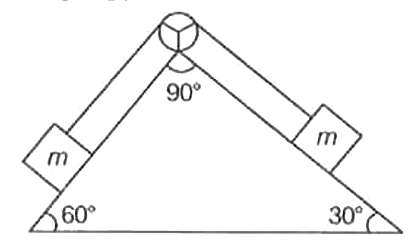 Solution in Telugu
Solution in Telugu
(√3−1√2)g
g2
(√3−1)g
(√3−14√2)g
The correct Answer is:D
For a pulley and block system on a smooth double inclined plane as shown below
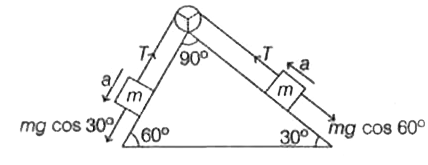
Force equation for both the blocks,
⇒mgcos30∘−T=ma …(i)
⇒T−mgcos60∘=ma …(ii)
From above equation we get,
a=√3−14g
∵ Magnitude of the acceleration of centre of mass,
aCM=∣∣∣ma1+ma2m+m∣∣∣
Here, aCM=∣∣
∣
∣∣(√3−14)gˆi+(√3−14)gˆj2∣∣
∣
∣∣
=g2
⎷(√3−14)gˆi+(√3−14)2
=g2×√2×√3−14
=(√3−14√2)g
Hence, option (d) is correct.
Topper's Solved these Questions
Similar Questions
Albert Einstein was confermed with the Nobel prize in physics for his work on
10:34View SolutionChoose the incorrect statement from the following
04:08View SolutionTwo blocks A and B of equal masses are attached to a string passing over a smooth pulley fixed to a wedge as shown in figure. Find the magnitude of acceleration of centre of mass of the two blocks when they are released from rest. Neglect friction.
08:08View SolutionIn which of the following cases the magnitude of acceleration of the block A will be maximum (neglecting friction, mass of pulley and string)
05:33View SolutionIn the arrangement shown in the figure, the blocks have masses 3m,m and 2m , the friction is absent, the masses of the pulleys and the threads are negligible. Find the acceleration of mass 3m .
05:59View SolutionFind the acceleration of the block of mass m in the arrangement shown in the following figures. The masses of the pulleys and the threads, as well as the friction are assumed to be negligible.
09:18View SolutionA block of mass m slides down on inclined wedge of same mass m as shown in figure . Friction is absent everywhere . Acceleration of centre of mass of the block and wedge is
View SolutionTwo blocks of equal mass are tied with a light string, which passes over a massless pulley as shown in figure. The magnitude of acceleration of centre of mass of both the blocks is : (neglect friction everywhere)
View SolutionString going over a pulley connects two blocks of masses m, and my. String and pulley are light. Calculate acceleration of centre of mass of blocks system.
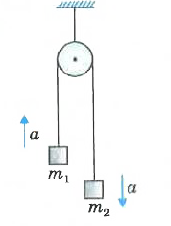 View Solution
View SolutionA block of mass m is arranged on the wedge as shown in figure . The wedge angle is θ. If the masses of pulley and thread and negligible and friction is absent , find the acceleration of the wedge
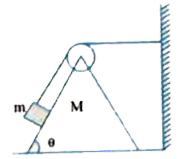 View Solution
View SolutionA block of mass m is arranged on the wedge as shown in figure . The wedge angle is theta . If the masses of pulley and thread and negligible and friction is absent , find the acceleration of the wedge
07:59View SolutionA block of mass m is arranged on the wedge as shown in figure . The wedge angle is θ. If the masses of pulley and thread are negligible and friction is absent , find the acceleration of the wedge .
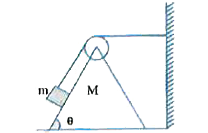 07:59View Solution
07:59View SolutionTwo blocks A and B of equal masses are attached to a string passing over a smooth pulley fixed to a wedge as shown in figure. Find the magnitude of acceleration of centre of mass of the two blocks when they are released from rest. Neglect friction.
08:59View SolutionA block of mass m slides down on inclined wedge of same mass m as shown in figure . Friction is absent everywhere . Acceleration of centre of mass of the block and wedge is
03:21View SolutionTwo blocks A and B of equal masses are attached to a string passing over a smooth pulley fixed to a wedge as shown in figure. Find the magnitude of acceleration of centre of mass of the two blocks when they are released from rest. Neglect friction.
02:53View Solution

